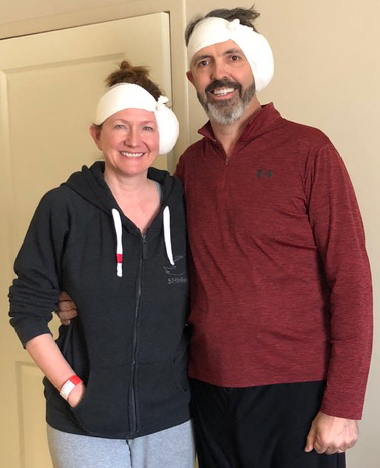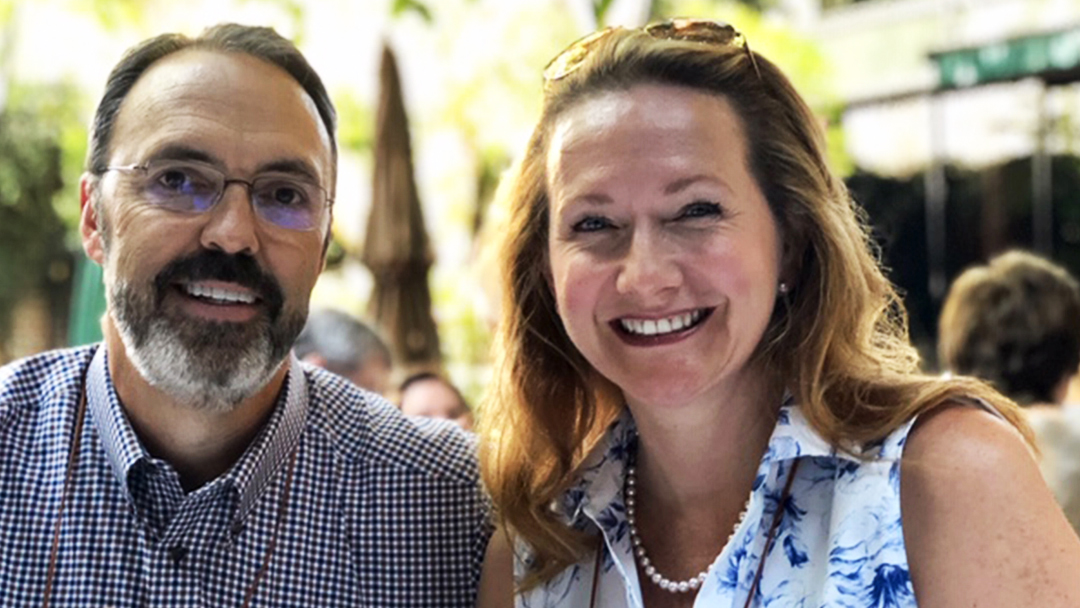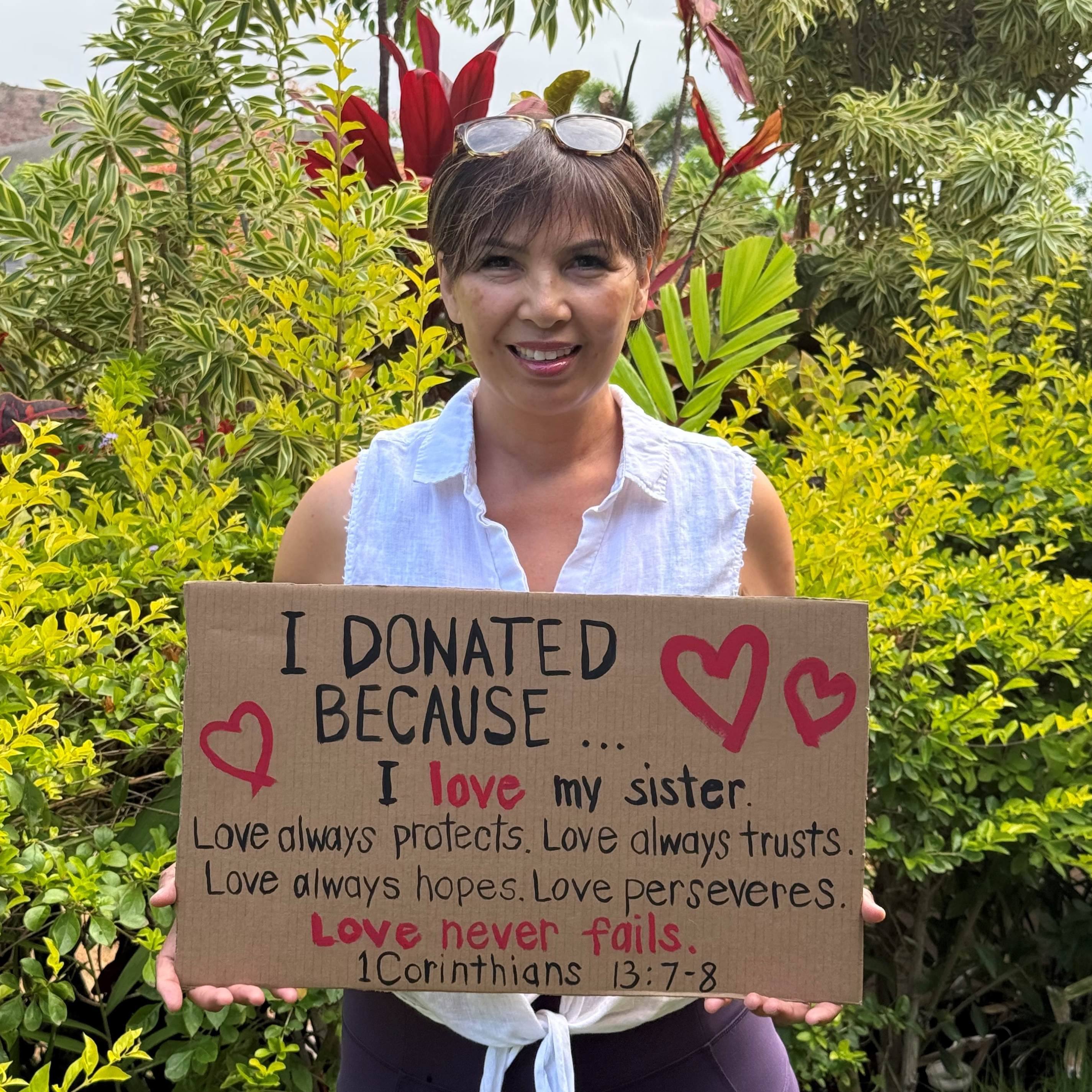-
Living and Loving Out Loud
Affected by hearing loss for years, Jerry and Madalaine McDaniel created a world for themselves that revolved around their quiet home environment. But when the couple was offered a chance to escape the silence, they leaped at the possibility of a return to sound.
From the start, hearing loss was a part of Madalaine and Jerry McDaniels' relationship. When the two met 11 years ago, Madalaine was completely deaf in one ear and partially deaf in the other. The pair fell in love and wed. Two years into their marriage, Jerry experienced sudden and complete hearing loss in his left ear.
Madalaine and Jerry tried using hearing aids but found them largely ineffective in crowds. As a result, the pair became less and less social. As their world shrank, they mostly stayed at their Effingham, Illinois, home with their children.
But then, in 2018, an appointment with a new health care provider pointed Jerry and Madalaine to a way of escaping the silence. Both were able to receive cochlear implants at Mayo Clinic. Today, the two are giddy about their renewed hearing, and they relish their ability to fully communicate.
"Now that we both have our hearing, it's really deepened our relationships, especially with our kids," Madalaine says.
A small, safe space
Before they received the cochlear implants, hearing loss had a profound effect on the McDaniels' daily life. After Madalaine and Jerry got married, Madalaine quit her position in corporate sales to become a stay-at-home mom. She began blogging about cooking — a job she could do alone.
After Jerry lost his hearing in one ear, the family consistently chose quiet dinners at home with each other and their children rather than visiting restaurants, where conversation was challenging.
"I was having anxiety about being in groups of people of more than two or three in a crowded situation," Madalaine says. "I'd hear things I thought were being said and respond, only to have people look at me like I was stupid and half crazy. I started withdrawing."
"I was having anxiety about being in groups of people of more than two or three in a crowded situation."
Madalaine McDaniel
As life beyond the safety of their home shrank, Jerry sought ways to push back against the wall of deafness forming around them. He learned about cochlear implantation and thought it might be able to help. But each inquiry he made into the procedure was met with a denial because he and Madalaine each still had hearing in one ear.
The pair continued on in the small, safe space they'd made for themselves, until one day early in winter 2018 when Jerry had an exam with a new primary care physician. At the appointment, after Jerry explained his hearing loss, his physician asked if Jerry had considered cochlear implantation. The physician went on to explain that another of his patients recently had a singular device implanted at Mayo Clinic. Jerry realized this could be the chance he'd been looking for.
A joint journey
A few weeks later, Jerry and Madalaine met with Mayo Clinic surgeon Colin Driscoll, M.D., in the Department of Otorhinolaryngology (ENT)/Head and Neck Surgery. Prior to the couple's consultation with Dr. Driscoll, Madalaine didn't fully grasp the extent of her hearing problem.
"It just really slowly deteriorated, and I didn't realize how much hearing I'd lost," she says.
Madalaine's descent into hearing loss began in 1999, when, as a new mother in her mid-20s, she developed Ménière's disease. In addition to hearing loss, Ménière's causes vertigo, ringing in the ear (tinnitus), and ear pressure.
"Not only did I have vertigo and dizzy spells and violent episodes of throwing up, but also intense, intense tinnitus," Madalaine says. "I also went almost completely deaf in both ears."
In the early 2000s, Madalaine's condition improved somewhat, and she began using hearing aids. At the time, Madalaine worked in corporate medical sales and labored to succeed in her profession.
"I got really good at reading lips and guessing context," Madalaine says. "In my professional life, people would say to me, 'Madalaine, you are so intense.' And I'm one of the most laid back people you'd meet. But in a conversation, especially in a crowded room, I'd have to really lean in and really focus on what somebody was saying. So it was kind scary for the person I was talking to."
"I used to run a business, and my whole life had been about talking people into things. And all of a sudden, I can't hear them anymore. It was miserable."
Jerry McDaniel
When Madalaine met and started dating Jerry, the relationship was long-distance. The pair spent a lot of time conversing and getting to know one another over the phone. "Which was great, because I could really hear him," Madalaine says.
During their early years as spouses, Madalaine and Jerry used humor to laugh about miscommunications caused by Madalaine not hearing or mishearing something. "But there is a high level of frustration when one person in the relationship has perfect hearing and the other person struggles," Madalaine says.
That changed eight years ago. When Jerry was on a campout with his son, he woke in the middle of the night to a loud noise, which resembled the droning of insects. Jerry attempted to locate the noise, but soon realized the sound was coming from his own ear. He was diagnosed with sudden sensorineural hearing loss. The condition may have been brought on by a virus that attacks the tiny hairs in the cochlea, which are essential structures for the transmission of electrical, sound-causing signals through the ear to the hearing nerve and the brain.
Jerry's abrupt entry in the world of hearing loss provided him new insight into Madalaine's experience with hearing aids and her desire to withdraw.
"I used to run a business, and my whole life had been about talking people into things. And all of a sudden, I can't hear them anymore," Jerry says. "It was miserable."
A potential path to hearing
While Jerry was eager and ready to get his hearing back, Madalaine was on the fence about whether a cochlear implant would solve her problems. "I was so frustrated with hearing aids that I didn't want to undergo this procedure and have it not work. I didn't want another failure," she says.
At Mayo Clinic, however, Madalaine gained a sense of the severity of her deafness. During a test to check her hearing, which Madalaine completed using high-tech hearing aids, Madalaine was asked to identify words against a backdrop of white noise.
"After the test, my audiologist came into the room," Madalaine says. "And I said to her: 'I nailed this! I don't need this surgery. I just need to use super-duper hearing aids!' She said, 'Madalaine, you got 42 percent correct.' I thought I had gotten 100 percent correct."
"Historically, the requirement for cochlear implantation is for both ears to be bad, but the trend is to try to look at each ear as an individual ear."
Colin Driscoll, M.D.
Following their hearing test, the pair met with Dr. Driscoll, who said they were both candidates for cochlear implantation.
"Historically, the requirement for cochlear implantation is for both ears to be bad, but the trend is to try to look at each ear as an individual ear." Dr. Driscoll says.
Because people hear in stereo, when one ear loses its ability to process sound, the brain struggles to pinpoint where noise is coming from and sort out sounds in noisy environments. The brain needs two ears to help individuals distinguish what it is they actually want to listen to from background noise.
"When you don't know where sound is coming from, it becomes a safety issue," Dr. Driscoll says, adding that cochlear implants help with both issues caused by single-sided hearing.
"People don't recognize they're a cochlear implant candidate because they say they can still hear and talk to me," Dr. Driscoll says. "They continue to struggle with hearing aids when really they would do better with a cochlear implant. It's really just the next step in hearing aids.
 When Jerry and Madalaine learned they were eligible for the surgery, Jerry asked if their operations could be scheduled on the same day. On April 11, 2018, they both were implanted with cochlear devices during outpatient procedures that each lasted less than two hours.
When Jerry and Madalaine learned they were eligible for the surgery, Jerry asked if their operations could be scheduled on the same day. On April 11, 2018, they both were implanted with cochlear devices during outpatient procedures that each lasted less than two hours.
A stereo-sound destination
Six weeks after their surgeries, Madalaine and Jerry returned to Mayo Clinic to have their devices activated, which involved attaching the exterior component of the device to the implant via magnetic connections. After activation, Madalaine and Jerry were given a listening exercise.
"They cut off all sound on my good ear, and the audiologist said a nursery rhyme," Madalaine explains. "It sounded like bees on the higher register and on the lower register there was this 'wha-wha-wha' bass tone, but in the middle I could hear words."
Madalaine repeated the nursey rhyme back to the audiologist, who seemed surprised and told Madalaine that very few patients decipher words the day of activation.
"I thought we were going to compete on who was going to get word identification first, and I didn't even get a chance," says Jerry, adding that his ability to put words to sounds generated by the implant followed a more traditional route.
Because the electrical signal generated by the implant is different than the signal generated by a natural cochlea, the brain must learn how to interpret the new signal. Dr. Driscoll explains that in some ways, the way the implant enables sound is different. But in many ways, it's the same.
"I feel so much more comfortable — so much more plugged into the real world."
Madalaine McDaniel
"Ultimately, it's still an electrical signal going down the hearing nerve to the brain, and that's how it's always been," he says.
Cochlear implant recipients typically realize the most progress in the performance of their device within the first six months of activation, explains Dr. Driscoll. "But people can continue to get better even longer than that. It's like a lot of things. If you work at it and do a lot of auditory training and listening, you'll make faster progress."
Jerry and Madalaine's path back to hearing has closed a large gap in their lives and opened up a door to a fuller, more robust world. This was especially true for Madalaine, whose detour through deafness lasted nearly 20 years.
"I really feel like I got my life back," Madalaine says. "I went in for my last hearing test, and with the hearing aid and cochlear synced, in a busy room with background noise, my hearing test came back with speech recognition at about 94 percent accuracy. I feel so much more comfortable — so much more plugged into the real world."
HELPFUL LINKS:
- Learn more about cochlear implants.
- Check out the Department of ENT/Head and Neck Surgery.
- Connect with others talking about hearing loss on Mayo Clinic Connect.
- Explore Mayo Clinic.
- Request an appointment.








